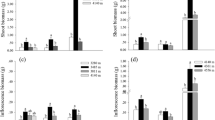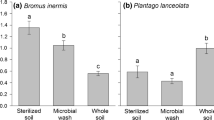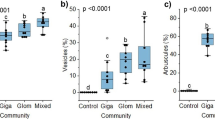Abstract
In order to evaluate host plant performance relative to different soil arbuscular mycorrhizal fungal (AMF) communities, Andropogon gerardii seedlings were grown with nine different AMF communities. The communities consisted of 0, 10, or 20 spores of Glomus etunicatum and 0, 10, or 20 spores of Glomus intraradices in all possible combinations. Spores were produced by fungal cultures originating on A. gerardii in a serpentine plant community; seeds of A. gerardii were collected at the same site. The experiment was performed in the greenhouse using a mixture of sterilized serpentine soil and sand to which naturally occurring non-mycorrhizal microbes were added. There was no difference in root AMF colonization rates between single species communities of either G. etunicatum or G. intraradices, but G. intraradices enhanced plant growth and G. etunicatum did not. However, plants grew larger with some combinations of G.␣intraradices plus G. etunicatum than with the same quantity of G. intraradices alone. These results suggest the potential for niche complementarity in the mycorrhizal fungi. That G. etunicatum only increased plant growth in the presence of G. intraradices could be illustrative of why AMF that appear to be parasitic or benign when examined in isolation are maintained within multi-species mycorrhizal communities in nature.
Similar content being viewed by others
References
Allen M.F. (2001). Modeling arbuscular mycorrhizal infection: is % infection an appropriate variable? Mycorrhiza 10:255–258
Anderson B. and Midgley J.J. (2002). It takes two to tango but three is a tangle: mutualists and cheaters on the carnivorous plant Roridula. Oecologia 132:369–373
Anderson R.C., Hetrick B.A.D. and Wilson G.W.T. (1994). Mycorrhizal dependence of Andropogon gerardii and Schizachyrium scoparium in two prairie soils. American Midland Naturalist 132:366–376
Aarssen L. (1997). High productivity in grassland ecosystems: effected by species diversity or productive species? Oikos 80:183–184
Banks M.K., Schwab A.P., Fleming G.R. and Hetrick B.A.D. (1994). Effects of plants and soil microflora on leaching of zinc from mine tailings. Chemosphere 29:1691–1699
Beaver J.D., Pringle A. and Schultz P.A. (2002). Dynamics within the plant-arbuscular mycorrhizal fungal mutualism: testing the nature of community feedback. In: van der Heijden M.G.A. and Sanders I.R. (eds) Mycorrhizal Ecology. Springer, New York, pp. 267–294
Bidartondo M.I., Redecker D., Hijri I., Wiemken A., Bruns T.D., Dominguez L., Sersic A., Leake J.R. and Read D.J. (2002). Epiparisitic plants specialized on arbuscular mycorrhizal fungi. Nature 419:389–392
Boddington C.L. and Dodd J.C. (1999). Evidence that differences in phosphate metabolism in mycorrhizas formed by species of Glomus and Gigaspora might be related to their life-cycle strategies. New Phytologist 142:531–538
Boucher D.H., James S. and Keeler K.H. (1982). The ecology of mutualism. Annual Review of Ecology and Systematics 13:315–347
Brooks R.T. (1987). Serpentine and its vegetation: a multi-disciplinary approach. Dioscorides Press, Portland
Brundrett M., Bougher N., Dell B., Grove T. and Malajczuk N. (1996). Working with mycorrhizas in forest and agriculture. ACIAR Monograph 32, Canberra
Castelli J.P. and Casper B.B. (2003). Intraspecific AM fungal variation contributes to plant-fungus feedback in a serpentine grassland. Ecology 84:323–336
Daniels B.A. and Skipper H.D. (1982). Methods for the recovery and quantitative estimation of propagules from soil. In: Schenck N.C. (eds) Methods and principles of mycorrhizal research. American Phytopathological Society Press, St. Paul, MN, pp. 29–35
Entry J.A., Rygiewicz P.T., Watrud L.S., and Donnelly P.K. (2002). Influence of adverse soil conditions on the formation and function of Arbuscular mycorrhizas. Advances in Soil Research 7:123–138
Filion M., St-Arnaud M. and Fortin J.A. (1999). Direct interaction between the arbuscular mycorrhizal fungus Glomus intraradices and different rhizosphere microorganisms. New Phytologist 141:525–533
Futuyma D.J. and Moreno G. (1988). The evolution of ecological specialization. Annual Review of Ecology and Systematics 19:207–234
Gemma J.N., Koske R.E. and Carreiro M. (1989). Seasonal dynamics of select species of V-A mycorrhizal fungi in a sand dune. Mycological Research 92:317–321
Graham J.H. and Abbott L.K. (2000). Wheat responses to aggressive and non-aggressive arbuscular mycorrhizal fungi. Plant and Soil 220:207–218
Gustafson D.J., and Casper B.B. (2004). Nutrient addition affects AM fungal performance and expression of plant / fungal feedback in three serpentine grasses. Plant and Soil 259:9–17
Hart M.M. and Reader R.J. (2002). Taxonomic basis for variation in the colonization strategy of arbuscular mycorrhizal fungi. New Phytologist 153:335–344
Hoeksema J.D. (1999). Investigating the disparity in host specificity between AM and EM fungi: lessons from theory and better-studied systems. Oikos 84:327–332
Huston M.A. (1997). Hidden treasures in ecological experiments: reevaluating the ecosystem function of biodiversity. Oecologia 110:449–460
INVAM (International Culture Collection of VA Mycorrhizal Fungi). 2002. [Online URL: <http://invam.caf.wvu.edu/>]
Janos D.P. (1985). Mycorrhizal fungi: agents or symptoms of tropical community succession? In: Molina R. (eds) Proceedings of the Sixth North American Conference on Mycorrhizae. Oregon State University Press, Corvalis, pp. 98–106
Janos D.P. (1987). VA mycorrhizas in humid tropical ecosystems. In: Safir G. (eds) VA mycorrhizae: an ecophysiological approach. CRC Press, Boca Raton, pp. 107–134
Johnson N.C., Graham J.H. and Smith F.A. (1997). Functioning of mycorrhizal associations along the mutualism-parasitism continuum. New Phytologist 135:575–585
Karagiannidis N. and Nikolaou N. (2000). Influence of arbuscular mycorrhizae on heavy metal (Pb and Cd) uptake, growth, and chemical composition of Vitis vinifera L. (cv. Razaki). American Journal of Enology and Viticulture 51:269–275
Klironomos J.N. (2003). Variation in plant response to native and exotic arbuscular mycorrhizal fungi. Ecology 84:2292–2301
Koide R.T. (2000). Functional complementarity in the arbuscular mycorrhizal symbiosis. New Phytologist 147:233–235
Kormanik P.P. and McGraw A.C. (1982). Quantification of vesicular arbuscular mycorrhizae in plant roots. In: Schenck N.C. (eds) Methods and principles of mycorrhizal research. American Phytopathological Society Press, St. Paul, MN, pp. 29–35
Li X. and Christie P. (2001). Changes in soil solution Zn and pH and uptake of Zn by arbuscular mycorrhizal red clover in Zn-contaminated soil. Chemosphere 42:201–207
Marschner P. and Baumann K. (2003). Changes in bacterial community structure induced by mycorrhizal colonization in split-root maize. Plant and Soil 251:279–289
Merryweather J. and Fitter A. (1998). The arbuscular mycorrhizal fungi of Hyacinthoides nonscripta. II Seasonal and spatial patterns of fungal populations. New Phytologist 138:131–142
McGonigle T.P., Miller M.H. and Evans D.G. (1990). A new method which gives an objective measure of colonization of roots by vesicular-arbuscular mycorrhizal fungi. New Phytologist 114:495–501
Pande M. and Tarafdar J.C. (2002). Effect of phosphorus, salinity and moisture on VAM fungal association in neem (Azadirachta indica Linn). Symbiosis 32:195–209
RuizLozano J.M. and Azcon R. (1995). Hyphal contribute to water uptake in mycorrhizal plants as affected by the fungal species and water status. Physiologia Plantarum 95:472–478
Sanders I.R. and Fitter A.H. (1992). Evidence for differential responses between host-fungus combinations of vesicular arbuscular mycorrhizas from a grassland. Mycological Research 96:415–419
Schultz P.A., Miller R.M., Jastrow J.D., Rivetta C.V. and Bever J.D. (2001). Evidence of a mycorrhizal mechanism for the adaptation of Andropogon gerardii (Poaceae) to high- and low-nutrient prairies. American Journal of Botany 88:1650–1656
Smith F.A. and Smith S.E. (1996). Mutualism and parasitism: diversity in function and structure in the “arbuscular” (VA) mycorrhizal symbiosis. Advances in Botanical Research 22:1–43
Smith F.A., Jakobsen I. and Smith S.E. (2000). Spatial differences in acquisition of soil phosphate between two arbuscular mycorrhizal fungi in symbiosis with Medicago truncatula. New Phytologist 147:357–366
Tilman D., Knops J., Wedin P., Reich P., Ritchie M. and Siemann E. (1997). The influence of functional diversity and composition on ecosystem processes. Science 277:1300–1302
Tilman D., Wedin D. and Knops D. (1996). Productivity and sustainability influenced by biodiversity in grassland ecosystem processes. Nature 379:718–720
van der Heijden M.G.A., Wiemken A. and Sanders I.R. (2003). Different arbuscular mycorrhizal fungi alter coexistence and resource distribution between co-occurring plants. New Phytologist 157:569–578
van der Heijden M.G.A., Boller T., Wiemken A. and Sanders I.R. (1998). Different arbuscular mycorrhizal fungal species are potential determinants of plant community structure. Ecology 79:2082–2091
Waser N.M., Chittka L., Price M.V., Williams N.M. and Ollerton J. (1996). Generalization in pollination systems, and why it matters. Ecology 77:1043–1060
Wilson G.W.T., Hetrick B.A.D. and Kit D.G. (1988). Suppression of mycorrhizal growth response of big bluestem by non-sterile soil. Mycologia 80:388–343
Wright W., Fitter A. and Meharg A. (2000). Reproductive biomass in Holcus lanatus clones that differ in their phosphate uptake kinetics and mycorrhizal colonization. New Phytologist 146:493–501
Acknowledgements
We gratefully acknowledge P. James and L. Willetts for assistance in the laboratory and J. Doherty, B. Ji, J. Klemens, R. Lucas, K. Rowley, L. Spindler, and anonymous reviewers for providing helpful comments on the manuscript. We thank the Nottingham County Park for allowing us access to the Nottingham field site.
Author information
Authors and Affiliations
Corresponding author
Rights and permissions
About this article
Cite this article
Gustafson, D.J., Casper, B.B. Differential host plant performance as a function of soil arbuscular mycorrhizal fungal communities: experimentally manipulating co-occurring Glomus species. Plant Ecol 183, 257–263 (2006). https://doi.org/10.1007/s11258-005-9037-8
Received:
Accepted:
Published:
Issue Date:
DOI: https://doi.org/10.1007/s11258-005-9037-8




